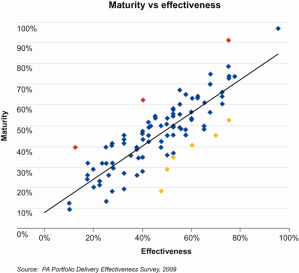Organizations that undertake a significant level of project work are under perpetual pressure to do it better. This might be because of customer or market-driven pressure, the desire to focus effort on more of the ‘right things,’ the need to do more with the same (or less) or an aspiration for increased profit by doing things more cost effectively.
Many emerging maturity models appear to be predicated on the presumption that ‘best practice’ is an absolute, and if sufficient of the many prescribed practices are documented and complied with, an organization’s outcomes will be better. While this might be true, it is rather undiscriminating and might imply a huge and expensive challenge for an organization to consider
We conducted a diagnostic survey to investigate the relationship between organizations’ project portfolio management practice maturity and the resulting outcomes they enjoy. We obtained responses from over 100 organizations from a range of sectors in the US and Europe – notably communications and media, energy and utilities, healthcare, financial services and professional services firms.
The survey explored a number of dimensions:
- Organizational characteristics – including industry, size, the extent and nature of their project portfolios and the planning and delivery models (whether centralized, decentralized or hybrid)
- Practice maturity – a measure of the quality of a range of their practices: what organizations do
- Delivery effectiveness – a measure of the quality of a range of outcomes organizations experience as a result – what organizations get.
The analysis of responses confirmed that there is, indeed, a clear correlation between overall maturity and effectiveness. This is illustrated below in the distribution of survey respondents by maturity and resulting effectiveness.
In general, enhancing the maturity of an organization’s practices will result in improvements in overall delivery effectiveness. In other words, the more an organization puts in to managing its portfolio of projects, and the means of delivery, the more its gets out.
While this was to be expected, there were a number of exceptions:
- Outliers with apparently mature processes reported relatively unsatisfactory outcomes (those highlighted in red)
- Similarly, outliers with ad-hoc processes reported disproportionately favorable outcomes (those highlighted in orange).
The first outliers were all very large organizations, with substantial portfolios of large projects, all operating under centralized planning and delivery models. The majority of the latter were small to medium sized organizations, with much smaller projects, operating under decentralized or hybrid/federated planning and delivery models.
Organizations in the first group have made significant investments in standards, tools and processes but these may not be supported by the necessary communication and behaviors to deliver success. The reverse appears to be true with the latter group.
So while practice maturity is important, it’s not the only thing. Clearly, organizational complexity and culture play a part in an organization’s ability to deliver effectively, as do the capabilities of its people.
Tim Pare

